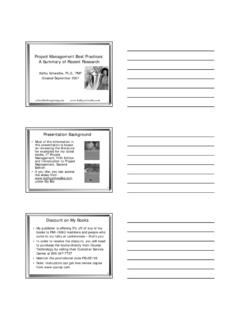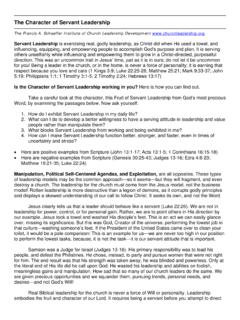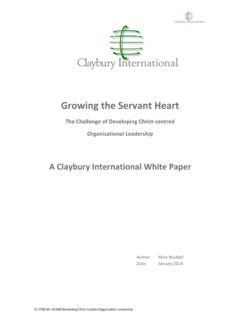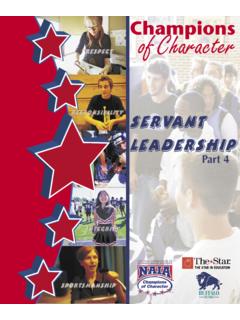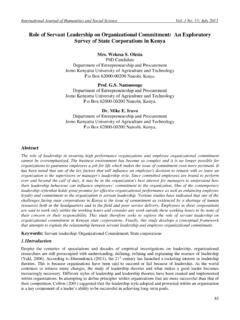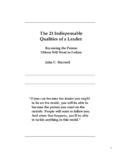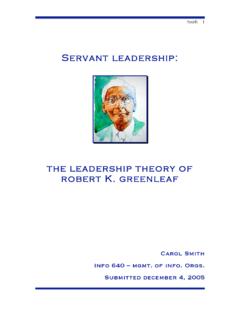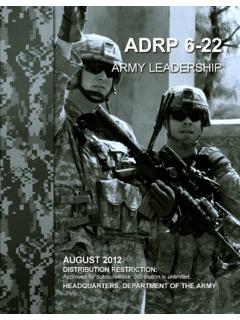Transcription of Character and Servant-Leadership - mydlc.com
1 Character and Servant-Leadership :Ten Characteristics of Effective, Caring LeadersBy Larry C. Spears, President & CEO, The Spears with permission of the fundamental understanding of Character has much to do with the essential traitsexhibited by a person. In recent years there has been a growing interest in the nature ofcharacter and Character education, based upon a belief that positive Character traits can beboth taught and learned. Many people today are familiar with the Character Counts!(sm)program of the Josephson Institute of Ethics. That program has been adopted by anumber of schools and communities nationwide and teaches core values which they call Six Pillars of Character . Those six particular Character values are: trustworthiness,respect, responsibility, fairness, caring, and nature of Character and its relationship to leaders has also taken on increasedsignificance in recent years. A number of noted leadership authors have looked at issuesof a leader s Character .
2 James Hillman, in The Soul s Code: In Search of Character andCalling, describes the invisible source of personal consistency, for which I am using theword `habit, psychology today calls Character . Character refers to deep structures ofpersonality that are particularly resistant to change. (p. 260).The literature on leadership includes a number of different listings of Character traits aspracticed by leaders. I particularly like Warren Bennis s short list as contained in hisbook, On Becoming a Leader, in which he identifies, vision, inspiration, empathy andtrustworthiness as key characteristics of effective leaders. (p. 140). Much of theleadership literature includes as an implicit assumption the belief that positivecharacteristics can-and-should be encouraged and practiced by leaders. Robert , the originator of the term, Servant-Leadership , is someone who thought andwrote a great deal about the nature of Servant-Leadership and and CharacterThe servant-leader is servant first.
3 It begins with the natural feeling that one wants toserve. Then conscious choice brings one to aspire to lead. The best test is: do thoseserved grow as persons: do they, while being served, become healthier, wiser, freer,more autonomous, more likely themselves to become servants ? And, what is the effect onthe least privileged in society; will they benefit, or, at least, not be further deprived?The Servant as LeaderRobert K. GreenleafWith that definition in 1970, retired AT&T executive Robert K. Greenleaf (1904-1990)coined the term Servant-Leadership and launched a quiet revolution in the way in whichwe view and practice leadership . Three decades later the concept of Servant-Leadership is2increasingly viewed as an ideal leadership form to which untold numbers of people andorganizations aspire. In fact, we are witnessing today an unparalleled explosion ofinterest in, and practice of, are experiencing a rapid shift in many businesses and not-for-profit organizations--away from the more traditional autocratic and hierarchical models of leadership andtoward Servant-Leadership as a way of being in relationship with others.
4 Servant-Leadership seeks to involve others in decision-making, is strongly based in ethical andcaring behavior, and enhances the growth of workers while improving the caring andquality of organizational words servant and leader are usually thought of as being opposites. In deliberatelybringing those words together in a meaningful way, Robert Greenleaf gave birth to theparadoxical term Servant-Leadership . In the years since then, many of today s mostcreative thinkers are writing and speaking about Servant-Leadership as an emergingleadership paradigm for the twenty-first century. The list is long and includes: JamesAutry, Warren Bennis, Peter Block, John Carver, Stephen Covey, Max DePree, JosephJaworski, James Kouzes, Larraine Matusak, Parker Palmer, M. Scott Peck, Peter Senge,Peter Vaill, Margaret Wheatley, and Danah Zohar, to name but a few of today s cutting-edge leadership authors and advocates of Servant-Leadership . In her groundbreaking bookon quantum sciences and leadership , Rewiring the Corporate Brain (Berrett-Koehler,1997), Zohar goes so far as to state that, Servant-Leadership is the essence of quantumthinking and quantum leadership .
5 (p. 146)Ten Characteristics of a Servant-LeaderAfter some years of carefully considering Greenleaf s original writings, I have identifieda set of ten characteristics of the servant-leader that I view as being of criticalimportance--central to the development of servant-leaders. My own work currentlyinvolves a deepening understanding of the following characteristics and how theycontribute to the meaningful practice of Servant-Leadership . These ten characteristicsinclude:Listening: Leaders have traditionally been valued for their communication and decision-making skills. Although these are also important skills for the servant-leader, they needto be reinforced by a deep commitment to listening intently to others. The servant-leaderseeks to identify the will of a group and helps to clarify that will. He or she listensreceptively to what is being said and unsaid. Listening also encompasses hearing one sown inner voice. Listening, coupled with periods of reflection, is essential to the growthand well-being of the : The servant-leader strives to understand and empathize with others.
6 Peopleneed to be accepted and recognized for their special and unique spirits. One assumes thegood intentions of co-workers and colleagues and does not reject them as people, evenwhen one may be forced to refuse to accept certain behaviors or performance. The mostsuccessful servant-leaders are those who have become skilled empathetic : The healing of relationships is a powerful force for transformation andintegration. One of the great strengths of Servant-Leadership is the potential for healingone s self and one s relationship to others. Many people have broken spirits and havesuffered from a variety of emotional hurts. Although this is a part of being human,servant-leaders recognize that they have an opportunity to help make whole those withwhom they come in contact. In his essay, The Servant as Leader, Greenleaf writes, There is something subtle communicated to one who is being served and led if, implicitin the compact between servant-leader and led, is the understanding that the search forwholeness is something they share.
7 Awareness: General awareness, and especially self-awareness, strengthens the servant-leader. Awareness helps one in understanding issues involving ethics, power and lends itself to being able to view most situations from a more integrated, holisticposition. As Greenleaf observed: Awareness is not a giver of solace--it is just theopposite. It is a disturber and an awakener. Able leaders are usually sharply awake andreasonably disturbed. They are not seekers after solace. They have their own innerserenity. Persuasion: Another characteristic of servant-leaders is reliance on persuasion, ratherthan on one s positional authority, in making decisions within an organization. Theservant-leader seeks to convince others, rather than coerce compliance. This particularelement offers one of the clearest distinctions between the traditional authoritarian modeland that of Servant-Leadership . The servant-leader is effective at building consensuswithin groups. This emphasis on persuasion over coercion finds its roots in the beliefs ofthe Religious Society of Friends (Quakers)--the denominational body to which RobertGreenleaf : Servant-leaders seek to nurture their abilities to dream greatdreams.
8 The ability to look at a problem or an organization from a conceptualizingperspective means that one must think beyond day-to-day realities. For many leaders,this is a characteristic that requires discipline and practice. The traditional leader isconsumed by the need to achieve short-term operational goals. The leader who wishes toalso be a servant-leader must stretch his or her thinking to encompass broader-basedconceptual thinking. Within organizations, conceptualization is, by its very nature, a keyrole of boards of trustees or directors. Unfortunately, boards can sometimes becomeinvolved in the day-to-day operations--something that should be discouraged--and, thus,fail to provide the visionary concept for an institution. Trustees need to be mostlyconceptual in their orientation, staffs need to be mostly operational in their perspective,and the most effective executive leaders probably need to develop both perspectiveswithin themselves. Servant-leaders are called to seek a delicate balance betweenconceptual thinking and a day-to-day operational : Closely related to conceptualization, the ability to foresee the likely outcomeof a situation is hard to define, but easier to identify.
9 One knows foresight when oneexperiences it. Foresight is a characteristic that enables the servant-leader to understandthe lessons from the past, the realities of the present, and the likely consequence of a4decision for the future. It is also deeply rooted within the intuitive mind. Foresightremains a largely unexplored area in leadership studies, but one most deserving of : Peter Block (author of Stewardship and The Empowered Manager) hasdefined stewardship as holding something in trust for another. RobertGreenleaf s view of all institutions was one in which CEO s, staffs, and trustees allplayed significant roles in holding their institutions in trust for the greater good ofsociety. Servant-Leadership , like stewardship, assumes first and foremost a commitmentto serving the needs of others. It also emphasizes the use of openness and persuasion,rather than to the growth of people: Servant-leaders believe that people have anintrinsic value beyond their tangible contributions as workers.
10 As such, the servant-leader is deeply committed to the growth of each and every individual within his or herorganization. The servant-leader recognizes the tremendous responsibility to doeverything in his or her power to nurture the personal and professional growth ofemployees and colleagues. In practice, this can include (but is not limited to) concreteactions such as making funds available for personal and professional development, takinga personal interest in the ideas and suggestions from everyone, encouraging workerinvolvement in decision-making, and actively assisting laid-off employees to find community: The servant-leader senses that much has been lost in recenthuman history as a result of the shift from local communities to large institutions as theprimary shaper of human lives. This awareness causes the servant-leader to seek toidentify some means for building community among those who work within a giveninstitution. Servant-Leadership suggests that true community can be created among thosewho work in businesses and other institutions.
